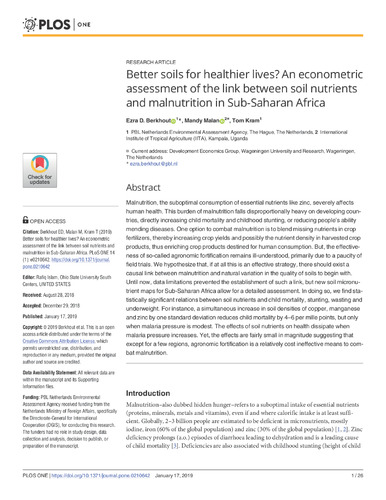Better soils for healthier lives? An econometric assessment of the link between soil nutrients and malnutrition in sub-Saharan Africa
Abstract
Malnutrition, the suboptimal consumption of essential nutrients like zinc, severely affects human health. This burden of malnutrition falls disproportionally heavy on developing countries, directly increasing child mortality and childhood stunting, or reducing people’s ability mending diseases. One option to combat malnutrition is to blend missing nutrients in crop fertilizers, thereby increasing crop yields and possibly the nutrient density in harvested crop products, thus enriching crop products destined for human consumption. But, the effectiveness of so-called agronomic fortification remains ill-understood, primarily due to a paucity of field trials. We hypothesize that, if at all this is an effective strategy, there should exist a causal link between malnutrition and natural variation in the quality of soils to begin with. Until now, data limitations prevented the establishment of such a link, but new soil micronutrient maps for Sub-Saharan Africa allow for a detailed assessment. In doing so, we find statistically significant relations between soil nutrients and child mortality, stunting, wasting and underweight. For instance, a simultaneous increase in soil densities of copper, manganese and zinc by one standard deviation reduces child mortality by 4–6 per mille points, but only when malaria pressure is modest. The effects of soil nutrients on health dissipate when malaria pressure increases. Yet, the effects are fairly small in magnitude suggesting that except for a few regions, agronomic fortification is a relatively cost ineffective means to combat malnutrition.

